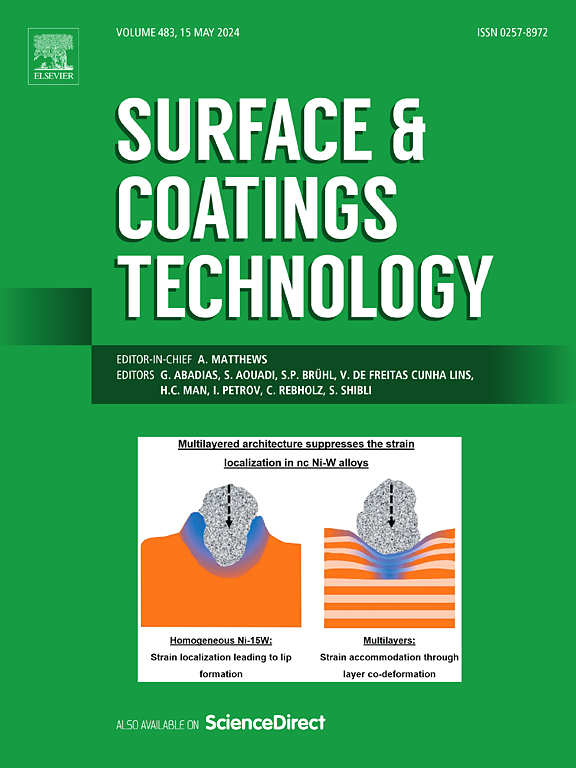Influence of pulse length and N2 flow rate on CrxN coatings prepared by HiPIMS
IF 5.3
2区 材料科学
Q1 MATERIALS SCIENCE, COATINGS & FILMS
引用次数: 0
Abstract
CrXN coatings were fabricated using High-Power Impulse Magnetron Sputtering (HiPIMS). The influence of pulse length and nitrogen (N2) flow rate on the microstructure and performance of the coatings was systematically investigated. Long-pulse (100 μs) and short-pulse (50 μs) modes were employed under varying N2 flow rates (5–35 sccm) to evaluate their impact on coating composition, crystalline phases, mechanical properties, and electrochemical corrosion resistance. Short-pulse mode effectively mitigates target poisoning, sustains high ion bombardment density, and significantly enhances coating density, hardness (40.8 GPa), and corrosion resistance. In contrast, the long-pulse mode achieves enhanced mechanical and corrosion resistance properties at low N2 flow rates, primarily due to reduced target poisoning and higher peak currents. The findings provide theoretical and practical insights for optimizing HiPIMS parameters to achieve tailored coating performance in diverse application environments.
脉冲长度和N2流量对HiPIMS制备CrxN涂层的影响
采用高功率脉冲磁控溅射技术制备了CrXN涂层。系统地研究了脉冲长度和氮气流量对涂层组织和性能的影响。采用长脉冲(100 μs)和短脉冲(50 μs)模式,在不同的N2流量(5 ~ 35 sccm)下,考察其对涂层成分、晶相、力学性能和电化学耐蚀性的影响。短脉冲模式能有效减轻靶中毒,维持高离子轰击密度,显著提高涂层密度、硬度(40.8 GPa)和耐腐蚀性。相比之下,在低氮气流速下,长脉冲模式的机械性能和耐腐蚀性得到了增强,这主要是由于减少了靶中毒和更高的峰值电流。研究结果为优化HiPIMS参数以实现不同应用环境下的定制涂层性能提供了理论和实践见解。
本文章由计算机程序翻译,如有差异,请以英文原文为准。
求助全文
约1分钟内获得全文
求助全文
来源期刊

Surface & Coatings Technology
工程技术-材料科学:膜
CiteScore
10.00
自引率
11.10%
发文量
921
审稿时长
19 days
期刊介绍:
Surface and Coatings Technology is an international archival journal publishing scientific papers on significant developments in surface and interface engineering to modify and improve the surface properties of materials for protection in demanding contact conditions or aggressive environments, or for enhanced functional performance. Contributions range from original scientific articles concerned with fundamental and applied aspects of research or direct applications of metallic, inorganic, organic and composite coatings, to invited reviews of current technology in specific areas. Papers submitted to this journal are expected to be in line with the following aspects in processes, and properties/performance:
A. Processes: Physical and chemical vapour deposition techniques, thermal and plasma spraying, surface modification by directed energy techniques such as ion, electron and laser beams, thermo-chemical treatment, wet chemical and electrochemical processes such as plating, sol-gel coating, anodization, plasma electrolytic oxidation, etc., but excluding painting.
B. Properties/performance: friction performance, wear resistance (e.g., abrasion, erosion, fretting, etc), corrosion and oxidation resistance, thermal protection, diffusion resistance, hydrophilicity/hydrophobicity, and properties relevant to smart materials behaviour and enhanced multifunctional performance for environmental, energy and medical applications, but excluding device aspects.
 求助内容:
求助内容: 应助结果提醒方式:
应助结果提醒方式:


